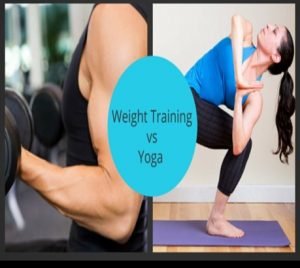CARDIO Vs WEIGHT TRAINING Vs YOGA
Determining what you are looking to achieve from your exercise drastically changes the exercises that would work best for you. A workout routine for someone who is looking to lose weight is very different from one for someone who wants to gain muscle. Knowing what your goals are, is the best way to determine your workout routine.
Some common variants of fitness regimes are Cardiovascular training, Resistance training and Yoga.
CARDIO
These help you burn more calories and are usually of lower intensity and sustained effort, however can also be shorter bouts of high intensity in some methods.
Cardio exercise uses large muscle movement over a sustained period of time keeping your heart rate to at least 50% of its maximum level.
Cardio exercise is any exercise that raises your heart rate.Movement makes the muscles stronger and stronger muscles make for a more efficient and healthy body.
Some of the Best Cardio Workouts Are:
Walking – This is the easiest and safest way to start getting in your cardio.
Elliptical – Minimal impact on the knees and hips but calorie burning is still high. When you increase the incline you will activate more muscles.
Running – This one is easy to understand. Just remember if you train like a distance runner you will look like a distance runner. If you train like a sprinter you will develop a sprinters body. Steady running burns calories but sprints take it to the next level.
High Intensity Interval Training – Short intervals at maximum intensity followed by short periods of rest. Best all around workout that burns fat and calories commonly known by the Tabata method.
Bike Riding or Cycling – Cycling uses large muscle groups in the legs and helps elevate your heart rate. This one is great you and you can do it indoors or outdoors.
Stair Climber – Uses more muscles than walking.
Jumping Rope – Cheap, easy and burns tons of calories. If you remember doing this for hours as a kid you will be surprised at how exhausted you will get now.
Swimming – This is a total body workout as long as you are not just floating – even treading water burns calories. Swimming laps would be best and change up the strokes you use so that you work all different kinds of muscles and the continuous pace works your heart and lungs.
Rowing – Works both the upper and lower body and is low stress on joints and ligaments.
Circuit Training – When you work out at a high intensity the blood starts to pump a lot harder and that challenges the elasticity of the arterial wall.

WEIGHT TRAINING
Resistance, or strength, training increases muscular fitness, which includes both muscular strength and muscular endurance. Muscle strength is the ability of the muscle to exert force, whereas muscle endurance is the ability of the muscle to continue to perform without fatigue. This form of training includes exercises performed using weights, weight machines, resistance bands, or one’s own body weight as resistance (e.g., pushups and squats). Regular resistance training can increase muscular strength, muscular endurance, and functional capacity .
YOGA–
Yoga relies on your own your entire body for strengthening . The way resistance classes use weights and other equipments , in yoga through different poses,your full body becomes toned and stronger by using your entire body weight as “weights”. Yoga is closely intertwined with breathing methods and poses that involve multiple joints to participate simultaneously.
Core components of yoga involve poses called asanas which work on many systems of our body. Yoga’s health benefits include increased fitness, stress reduction, weight loss and management of chronic conditions, such as pain, anxiety, depression and sleep problems.
1 .Better Body Image –
Focussing inward during yoga helps you to be more satisfied with your body and less critical of it.
2.Heart benefits–
Yoga can help lower blood pressure , cholesterol and blood sugar,all of which are good for heart abd blood vessels.
3.Overall fitness-
Practicing yoga a couple times a week increases muscle strength and flexibility ,boosts endurance and tunes up heart ,lungs and vessels.
4.Mindful eating -Being more aware of how body feels carrier over to mealtimes.
5.Weight control- Mindfulness developed through yoga makes you more sensitive to cues of hunger and fullness, which help you develop a more positive relationship with food.
Whichever form of exercises you chose , at Ability we can guide you in progressions and tips to stay injury free helping you take your fitness journey ahead.
References:-
1.Akhtar P, Yardi S, Akhtar M. Effects of yoga on functional capacity and well-being. Int J Yoga. 2013;6:76–9. [PMC free article] [PubMed]
2. Ross A, Thomas S. The health benefits of yoga and exercise: A review of comparison studies. J Altern Complement Med. 2010;16:3–12. [PubMed]

